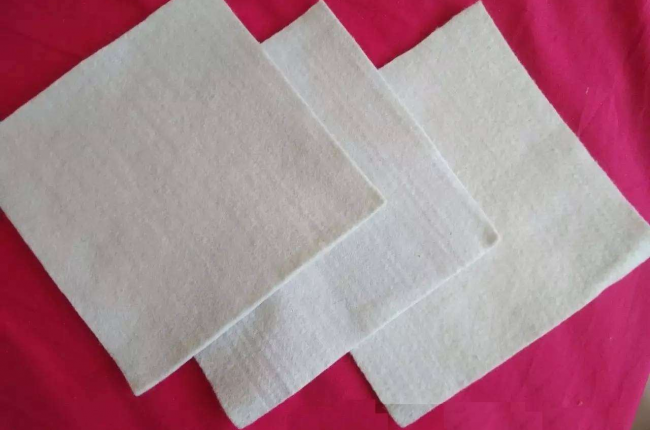Nonwoven geotextile is a permeable geosynthetic material made of synthetic fibers through needling or weaving. It is a new type of construction material specified by the state and used in civil engineering. It is made of long filaments or short fibers which are laid into a network through different equipment and processes, and then different fibers are intertwined with each other through needling and other processes, so as to standardize the fabric, make the fabric soft, full, thick and rigid, so as to meet the use requirements with different thicknesses, According to the length of the filament, it can be divided into long filament non-woven geotextile or short filament non-woven geotextile. The tensile strength of the filament is higher than that of the short filament. Because the fiber is soft, it has certain tear resistance and good filterability. Geotextile has the characteristics of light weight, high tensile strength, good water permeability, high temperature resistance, freezing resistance, aging resistance and corrosion resistance. The main functions are: reverse filtration, water filtration and reinforcement. Specifications range from 100 grams per square meter to 800 grams per square meter. The main material is polyester fiber, which has excellent water permeability, filtration, durability, deformation adaptability, and good plane drainage capacity.
Geotextiles have excellent physical and chemical properties and processing properties, good chemical stability, high rigidity and toughness, good mechanical strength, dielectric property, environmental stress cracking resistance, corrosion resistance, and good heat resistance and cold resistance.
1. The good air permeability and water permeability of the geotextile are used to make the flowing water pass through, thus effectively intercepting the sand loss.
2. Geotextile has good drainage performance. It can form a drainage channel in the soil body and shoot the excess liquid and gas in the soil structure.
3. Geotextile is used to enhance the tensile strength and deformation resistance of soil, and enhance the stability of building structure to improve the quality of soil.
4. It can effectively diffuse, transfer or decompose the concentrated stress and prevent the soil from being damaged by external forces.
5. Prevent mixing between upper and lower sand, soil and concrete.
6. The mesh structure formed by the amorphous fiber organization has the characteristics of strain and mobility, and the mesh opening is not easily blocked.
7. It can still maintain good water permeability under the pressure of water and soil.
8. With polypropylene fiber or polyester fiber as raw material, it is acid and alkali resistant, non corrosive, non moth and anti-aging.
9. Light weight, convenient use and simple construction.
characteristic:
Acid resistance: pet is very stable to acids (especially organic acids). It is soaked in 5% hydrochloric acid solution at 100 ℃ for 24h, or soaked in 70% sulfuric acid solution at 40 ℃ for 72h. Its strength is not lost, but it cannot resist the long-term action of concentrated sulfuric acid or concentrated nitric acid at room temperature.
Alkali resistance: relatively stable to dilute alkali at normal temperature.
Solvent resistance: pet has strong resistance to general non-polar organic solvents, and even to polar organic solvents at room temperature. For example, the fiber strength does not decrease after soaking in acetone, chlorine spinning, toluene, trichloroethylene and carbon tetrachloride for 24h at room temperature. Under heating, it can be dissolved in mixed solvents such as phenol, xylenol, o-dichlorophenol, benzyl alcohol, nitrobenzene, phenol carbon tetrachloride, phenol chloroform and phenol toluene.
Microbial resistance: pet is resistant to microorganisms, insects and fungi.
Thermal property: the polyester has good heat resistance, and the softening point is 238 ~ 240 ℃. The melting point of pet for general industrial products is 255-260 ℃. Pet can maintain its good physical and mechanical properties in a wide temperature range. It is less affected by temperature in the temperature range of - 20 ~ 80 ℃. The long-term use temperature can reach 120 ℃, and it can be used at 150 ℃ for a period of time.
Anti aging performance: pet geotextile has excellent anti-aging, anti ultraviolet and anti decomposition capabilities, and can be used naked. The service life of the material is 50-70 years, providing a good material guarantee for environmental seepage prevention. The construction speed is fast. The geotextile has high flexibility. There are various specifications and laying forms to meet the anti-seepage requirements of different projects. Hot melt welding is adopted. The weld strength is high, and the construction is convenient, fast and healthy.
Environmental protection and non toxicity: the materials used in the geotextile are all non-toxic and environmentally friendly new raw materials. The principle of reverse filtration is common physical change and does not produce any harmful substances. It is the best choice for environmental protection, aquaculture and drinking water.







 Product list
Product list
 contact us
contact us

